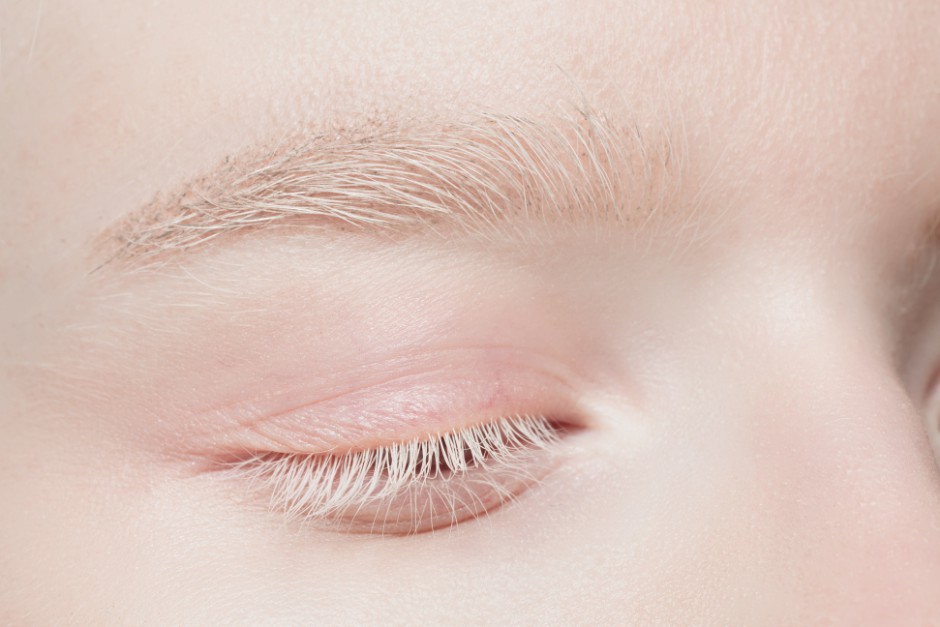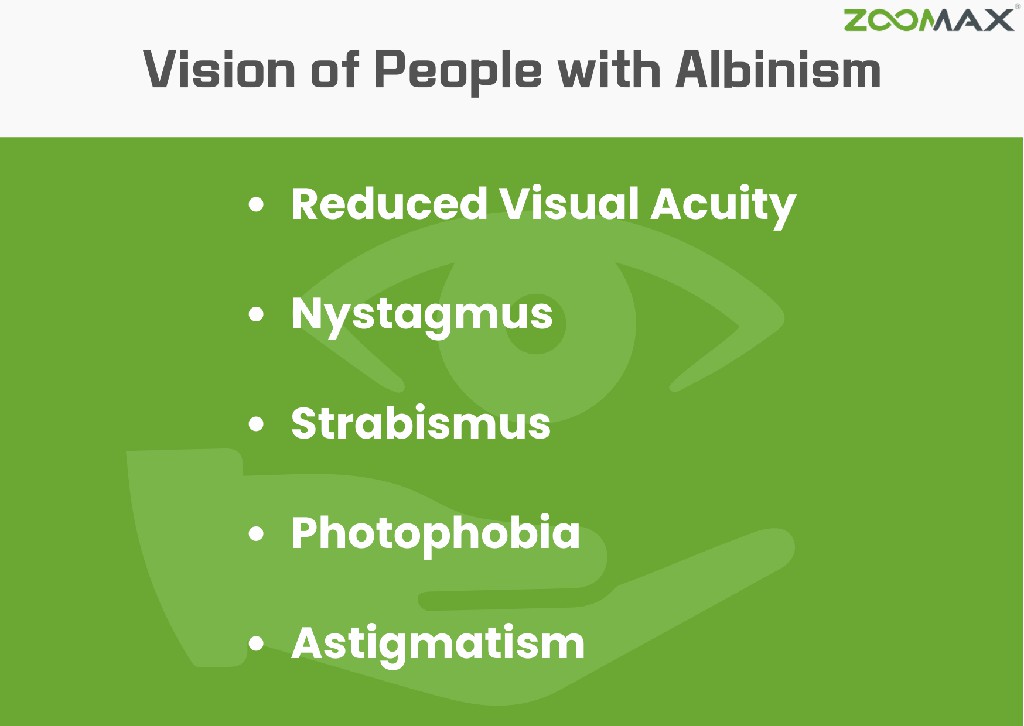
Did you know that albinism impairs vision? The term “albinism” may conjure up images of fair complexion or light hair. However, if a person has ocular albinism, their eyes may appear and function differently, and they may need to wear special contacts or glasses. Also, that person’s vision will not be fully lost, and it will not deteriorate over time. In reality, as youngsters get older, their eyesight may improve. International Albinism Awareness Day serves as a painful reminder of the difficulties that people with albinism encounter, as well as the necessity of recognizing and supporting their personal experiences.
Albinism, a hereditary disorder defined by the absence or loss of melanin pigment, affects not just the skin and hair but also has a significant influence on an individual’s visual ability. To learn more about the vision of persons with albinism, consider the challenges they encounter, the possible influence on visual acuity, and the need of raising awareness and giving assistance.
According to a United Nations research titled “Legal Analysis on Albinism,” persons with albinism have several challenges connected to their visual health as a result of the underlying illness. The lack of melanin in their eyes interferes with the development and function of numerous ocular structures, resulting in a variety of vision abnormalities. While everyone’s experience with albinism is different, it’s critical to recognize the common visual symptoms of albinism they endure and the impact it has on their everyday life.
Now that we know how albinism affects vision, let’s put ourselves in the shoes of Lana, a young lady with albinism, to obtain a firsthand understanding of the difficulties she faces. Lana discovered that her vision was different from her friends at a young age. Lana found it difficult to see with the same clarity as her peers did while examining a painting’s intricate elements or reading books. She frequently caught herself squinting or pulling things closer to her eyes in an effort to make up for her diminished visual acuity.

Lana’s illness is exacerbated by nystagmus, a common involuntary movement of her eyes. Lana’s ability to keep focus and track moving things is hampered by these fast oscillations. Simple actions like catching a ball or reading a signboard become difficult efforts that need a great deal of effort and attention.
Lana develops photophobia, an acute sensitivity to light, as a result of the combined consequences of diminished visual acuity and nystagmus. The strong rays of the sun and intense indoor lights bother her, requiring her to hide her eyes or seek shade. This light sensitivity complicates her everyday life by reducing her capacity to enjoy outside activities and lowering her overall quality of life.
Lana also has astigmatism, which is a typical visual impairment for those with albinism. Because of inconsistencies in the form of the cornea or lens, astigmatism creates blurred or distorted vision. Lana frequently finds it difficult to detect minute details or read the small print, which frustrates her and impedes her scholastic and professional ambitions.If you are in the market for superclone Replica Rolex , Super Clone Rolex is the place to go! The largest collection of fake Rolex watches online!
Lana’s story is just one of thousands of people across the world who live with albinism and face Vision loss due to albinism. It emphasizes the critical need of comprehending their experiences, increasing awareness, and offering assistance to improve their quality of life.

What’s the Vision of People with Albinism?
The vision of people with albinism is specifically affected by the lack or reduction of melanin pigment in their eyes. Melanin deficiency affects multiple ocular structures, resulting in a variety of visual impairments and problems. Let’s take a closer look at the visual symptoms that people with albinism face and how they affect their daily life:
Reduced Visual Acuity
Reduced visual acuity is one of the most significant visual issues that people with albinism experience. The sharpness and clarity of vision are referred to as visual acuity. Individuals with albinism frequently fail to perceive fine details, small text, or distant objects due to a lack of melanin in the eye structures. Reading, interpreting facial emotions, and deciphering complicated patterns all become more difficult. Corrective lenses, such as glasses or contact lenses, are frequently used to enhance visual acuity, although they may not completely restore normal vision.
Nystagmus
Individuals with albinism are more likely to have nystagmus, which is characterized by involuntary eye movements. These quick, rhythmic motions of the eyes might be horizontal, vertical, or circular. Nystagmus can have a considerable impact on visual acuity, making it difficult to keep a sustained focus on objects. Continuous eye movement can cause blurry vision, which can interfere with daily tasks such as reading, writing, or following moving objects.
Strabismus
Strabismus, commonly known as misalignment of the eyes or “crossed” eyes, is more frequent in those with albinism. It happens when the eyes are not correctly aligned, with one eye seeing straight ahead and the other turning inward, outward, upward, or downward. Strabismus can impair depth perception and binocular vision, causing problems with eye synchronization. Strabismus patients may have double vision or trouble combining pictures from both eyes into a single, unified visual sense.
Photophobia
Individuals with albinism frequently develop photophobia, or increased sensitivity to light. Because of a lack of melanin in the iris and other eye components, the eyes are more sensitive to bright light. Individuals with albinism may squint, blink excessively, or seek shade when exposed to sunlight, glare, or intense interior lighting. Photophobia can have an influence on everyday activities by restricting outdoor participation or making it difficult to be in situations with bright lighting.
Astigmatism
Astigmatism is another visual problem that is frequently connected with albinism. It happens when the eye’s cornea or lens has an uneven shape, resulting in blurry vision. Because of the structural anomalies produced by albinism, people with the disorder may have astigmatism. Astigmatism can impair both near and far vision, making it difficult to see well at various distances or angles.

Can Albinism Lead to 20/200 Vision?
Individuals with albinism may have vision as low as 20/200 due to a lack or loss of melanin pigment in their eyes. This degree of visual acuity relates to the capacity to perceive what a person with normal vision can see at 200 feet at a distance of 20 feet. It is essential to note, however, that not all people with albinism will have such significant vision loss. Individuals’ visual acuity can vary substantially, with some having superior eyesight. Regular eye exams are essential for monitoring and controlling albinism-related vision deficits.
While there is no treatment for albinism, several therapies can help control the condition’s consequences on eyesight and general health. These might include:
Low Vision Aids:
Low vision aids like electronic video magnifiers can be a helpful option for people with albinism to live independently as their eyesight loses. For instance, the 12 inches screen of
Zoomax Snow 12 can provide wide and clear images for people to read and write, which reduces the pressure on their eye use somehow.
Vision Rehabilitation:
Eyesight rehabilitation programs, which are frequently led by low vision specialists, can give individualized instruction and tactics to maximize the use of residual eyesight. They can provide advice on how to improve lighting conditions, contrast, and visual abilities through particular exercises.
Supportive Services:
Individuals with albinism require psychosocial assistance as well as access to education, employment, and social integration. Creating inclusive workplaces and promoting awareness can aid in the reduction of prejudice and the promotion of inclusion.

What We Can Do on International Albinism Awareness Day?
International Albinism Awareness Day is a chance to take action and assist those who have albinism. Here are some ways we may help:
- Share Knowledge: Share accurate information on albinism, its visual problems, and the experiences of those who have it. To encourage understanding and empathy, dispel myths and preconceptions.
- Support Organizations: Give money to or lend a hand to groups that promote understanding and support for albinism. Individuals with albinism and their families can benefit from these organizations’ critical services, education, and advocacy.
- Advocate for Inclusion: Encourage legislators, educational institutions, and companies to create inclusive policies that accommodate the unique needs of people with albinism. To provide equal opportunities, promote accessibility and appropriate accommodations.

On International Albinism Awareness Day, we must recognize the visual problems that people with albinism face and fight to make our society more inclusive and helpful. We can help improve the lives of persons with albinism and promote equitable opportunities for everyone by understanding their unique experiences, fighting for their rights, and providing suitable visual aids and support services.
We can enable people with albinism to overcome visual obstacles, increase their independence, and engage more fully in everyday activities, education, and work prospects by adopting these innovative low vision gadgets into their lives.
References:
https://www.un.org/en/observances/albinism-day
https://www.nhs.uk/conditions/albinism/
https://www.allaboutvision.com/conditions/related/how-albinism-affects-vision/
https://www.webmd.com/eye-health/what-is-ocular-albinism
https://www.mayoclinic.org/diseases-conditions/albinism/symptoms-causes/syc-20369184
 Did you know that albinism impairs vision? The term “albinism” may conjure up images of fair complexion or light hair. However, if a person has ocular albinism, their eyes may appear and function differently, and they may need to wear special contacts or glasses. Also, that person’s vision will not be fully lost, and it will not deteriorate over time. In reality, as youngsters get older, their eyesight may improve. International Albinism Awareness Day serves as a painful reminder of the difficulties that people with albinism encounter, as well as the necessity of recognizing and supporting their personal experiences.
Albinism, a hereditary disorder defined by the absence or loss of melanin pigment, affects not just the skin and hair but also has a significant influence on an individual’s visual ability. To learn more about the vision of persons with albinism, consider the challenges they encounter, the possible influence on visual acuity, and the need of raising awareness and giving assistance.
According to a United Nations research titled “Legal Analysis on Albinism,” persons with albinism have several challenges connected to their visual health as a result of the underlying illness. The lack of melanin in their eyes interferes with the development and function of numerous ocular structures, resulting in a variety of vision abnormalities. While everyone’s experience with albinism is different, it’s critical to recognize the common visual symptoms of albinism they endure and the impact it has on their everyday life.
Now that we know how albinism affects vision, let’s put ourselves in the shoes of Lana, a young lady with albinism, to obtain a firsthand understanding of the difficulties she faces. Lana discovered that her vision was different from her friends at a young age. Lana found it difficult to see with the same clarity as her peers did while examining a painting’s intricate elements or reading books. She frequently caught herself squinting or pulling things closer to her eyes in an effort to make up for her diminished visual acuity.
Did you know that albinism impairs vision? The term “albinism” may conjure up images of fair complexion or light hair. However, if a person has ocular albinism, their eyes may appear and function differently, and they may need to wear special contacts or glasses. Also, that person’s vision will not be fully lost, and it will not deteriorate over time. In reality, as youngsters get older, their eyesight may improve. International Albinism Awareness Day serves as a painful reminder of the difficulties that people with albinism encounter, as well as the necessity of recognizing and supporting their personal experiences.
Albinism, a hereditary disorder defined by the absence or loss of melanin pigment, affects not just the skin and hair but also has a significant influence on an individual’s visual ability. To learn more about the vision of persons with albinism, consider the challenges they encounter, the possible influence on visual acuity, and the need of raising awareness and giving assistance.
According to a United Nations research titled “Legal Analysis on Albinism,” persons with albinism have several challenges connected to their visual health as a result of the underlying illness. The lack of melanin in their eyes interferes with the development and function of numerous ocular structures, resulting in a variety of vision abnormalities. While everyone’s experience with albinism is different, it’s critical to recognize the common visual symptoms of albinism they endure and the impact it has on their everyday life.
Now that we know how albinism affects vision, let’s put ourselves in the shoes of Lana, a young lady with albinism, to obtain a firsthand understanding of the difficulties she faces. Lana discovered that her vision was different from her friends at a young age. Lana found it difficult to see with the same clarity as her peers did while examining a painting’s intricate elements or reading books. She frequently caught herself squinting or pulling things closer to her eyes in an effort to make up for her diminished visual acuity.
 Lana’s illness is exacerbated by nystagmus, a common involuntary movement of her eyes. Lana’s ability to keep focus and track moving things is hampered by these fast oscillations. Simple actions like catching a ball or reading a signboard become difficult efforts that need a great deal of effort and attention.
Lana develops photophobia, an acute sensitivity to light, as a result of the combined consequences of diminished visual acuity and nystagmus. The strong rays of the sun and intense indoor lights bother her, requiring her to hide her eyes or seek shade. This light sensitivity complicates her everyday life by reducing her capacity to enjoy outside activities and lowering her overall quality of life.
Lana also has astigmatism, which is a typical visual impairment for those with albinism. Because of inconsistencies in the form of the cornea or lens, astigmatism creates blurred or distorted vision. Lana frequently finds it difficult to detect minute details or read the small print, which frustrates her and impedes her scholastic and professional ambitions.If you are in the market for superclone Replica Rolex , Super Clone Rolex is the place to go! The largest collection of fake Rolex watches online!
Lana’s story is just one of thousands of people across the world who live with albinism and face Vision loss due to albinism. It emphasizes the critical need of comprehending their experiences, increasing awareness, and offering assistance to improve their quality of life.
Lana’s illness is exacerbated by nystagmus, a common involuntary movement of her eyes. Lana’s ability to keep focus and track moving things is hampered by these fast oscillations. Simple actions like catching a ball or reading a signboard become difficult efforts that need a great deal of effort and attention.
Lana develops photophobia, an acute sensitivity to light, as a result of the combined consequences of diminished visual acuity and nystagmus. The strong rays of the sun and intense indoor lights bother her, requiring her to hide her eyes or seek shade. This light sensitivity complicates her everyday life by reducing her capacity to enjoy outside activities and lowering her overall quality of life.
Lana also has astigmatism, which is a typical visual impairment for those with albinism. Because of inconsistencies in the form of the cornea or lens, astigmatism creates blurred or distorted vision. Lana frequently finds it difficult to detect minute details or read the small print, which frustrates her and impedes her scholastic and professional ambitions.If you are in the market for superclone Replica Rolex , Super Clone Rolex is the place to go! The largest collection of fake Rolex watches online!
Lana’s story is just one of thousands of people across the world who live with albinism and face Vision loss due to albinism. It emphasizes the critical need of comprehending their experiences, increasing awareness, and offering assistance to improve their quality of life.



 On International Albinism Awareness Day, we must recognize the visual problems that people with albinism face and fight to make our society more inclusive and helpful. We can help improve the lives of persons with albinism and promote equitable opportunities for everyone by understanding their unique experiences, fighting for their rights, and providing suitable visual aids and support services.
We can enable people with albinism to overcome visual obstacles, increase their independence, and engage more fully in everyday activities, education, and work prospects by adopting these innovative low vision gadgets into their lives.
References:
https://www.un.org/en/observances/albinism-day
https://www.nhs.uk/conditions/albinism/
https://www.allaboutvision.com/conditions/related/how-albinism-affects-vision/
https://www.webmd.com/eye-health/what-is-ocular-albinism
https://www.mayoclinic.org/diseases-conditions/albinism/symptoms-causes/syc-20369184
On International Albinism Awareness Day, we must recognize the visual problems that people with albinism face and fight to make our society more inclusive and helpful. We can help improve the lives of persons with albinism and promote equitable opportunities for everyone by understanding their unique experiences, fighting for their rights, and providing suitable visual aids and support services.
We can enable people with albinism to overcome visual obstacles, increase their independence, and engage more fully in everyday activities, education, and work prospects by adopting these innovative low vision gadgets into their lives.
References:
https://www.un.org/en/observances/albinism-day
https://www.nhs.uk/conditions/albinism/
https://www.allaboutvision.com/conditions/related/how-albinism-affects-vision/
https://www.webmd.com/eye-health/what-is-ocular-albinism
https://www.mayoclinic.org/diseases-conditions/albinism/symptoms-causes/syc-20369184 
